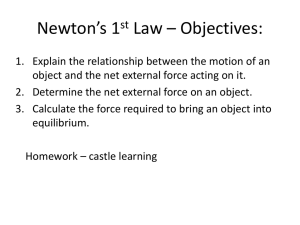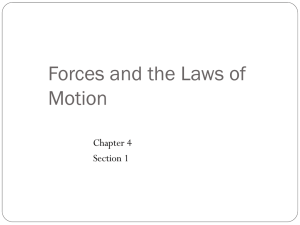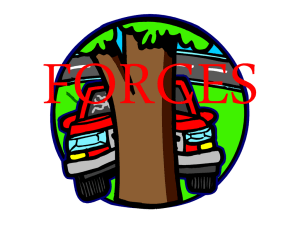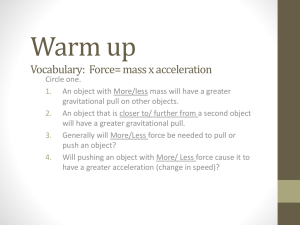1213_PHYS_ppt_ch_6
advertisement
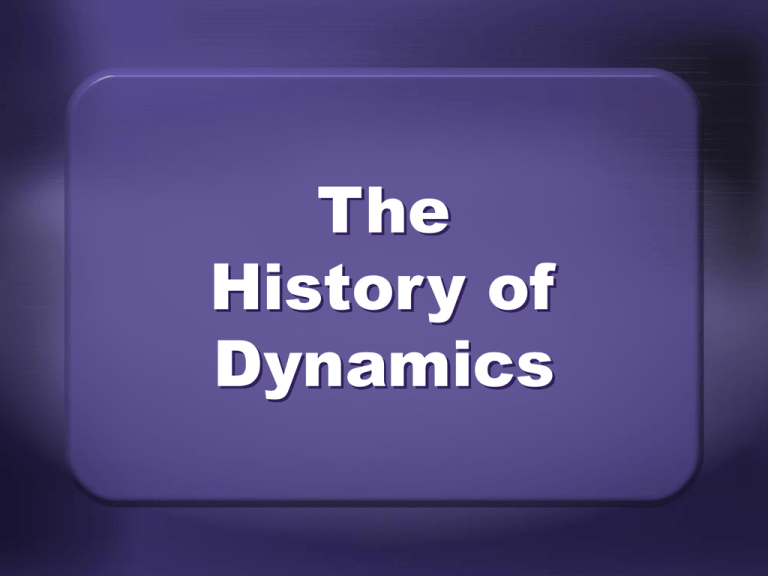
The History of Dynamics The Greeks Natural motion was caused by some internal quality of an object that made it seek a certain “preferred” position without any application of force. The Greeks Unnatural motion was anything else. Unnatural motion was thought to require applied force to be sustained. The Greeks Natural motions were divided into two categories: Terrestrial (near the earth) Celestial (in the heavens) The Greeks Aristotle taught that an object’s “heaviness” determined how “vigorously” it sought its natural place. Galileo • began by collecting facts and establishing a description of motion • This is called kinematics. • Galileo then inductively developed workable theories of dynamics. Galileo • Experiments showed that the rate at which an object falls is not proportional to its size or mass. • Astronauts later verified his theory on the moon. Ad hoc a hypothesis based on conjecture rather than observation, usually in an attempt to explain a natural phenomenon Inertia • Galileo’s experiments of “unnatural” motion indicated that the “natural” state of motion of an object could include moving as well as resting. Inertia Galileo’s Principle of Inertia: An object will continue in its original state of motion unless some outside agent acts on it. Inertia A moving object does not require a continuous push to maintain a constant velocity! A push causes a change in an object’s motion. Newton • • • • built on the work of others studied gravitation Principia only in recent decades have scientists discovered any exceptions to his work Forces Summing Forces • Forces are often described as “pushes” and “pulls.” • Forces are vectors. • Forces can be added just as vectors are added. Summing Forces • Notation: ΣF ≡ F1 + F2 + ... + Fn • The Greek capital letter sigma (Σ) is used to indicate a sum. Summing Forces • If forces are balanced... ΣF = 0 • ...and no change in motion will occur. ΣF = 0 ↔ ΣFx = 0 and ΣFy = 0 Unbalanced Forces • will change an object’s state of motion • there may be two, or more than two, forces which are unbalanced Unbalanced Forces • To find the sum of unbalanced forces, you add the force vectors acting upon the object. • This usually involves finding and adding the vector components. Equilibrant Force • a force that balances one or more other concurrent forces Equilibrant Force • a vector having the same magnitude as the vector sum of the other unbalanced forces but pointing in the opposite direction Fequil. = -ΣFother Equilibrant Force • If the sum of all forces on an object is zero, then any unknown force must be the equilibrant of all the known forces. Weight • the force of gravity acting on an object • a vector pointing straight downward • often notated Fw Types of Forces • All forces are classified as either fundamental forces or mechanical forces. • There are four fundamental forces. Fundamental Forces • Gravitational force • proportional to the masses of interacting objects • can exert its influence over theoretically infinite distances Fundamental Forces • Gravitational force • all objects exert gravitational force on all other objects Fundamental Forces • Electromagnetic force • used to explain both magnetism and electricity • a long-range force • a short-range force Fundamental Forces • Strong nuclear interaction force • Weak nuclear interaction force Classification of Forces • Noncontact Forces • gravity • electromagnetic forces • sometimes called “action-at-a-distance” forces Classification of Forces • Noncontact Forces • field theory attempts to explain these • virtual particles have been offered as an explanation Classification of Forces • Contact Forces • transmitted only by physical contact between objects • include the following: Classification of Forces tensile (pull things apart) compressive (push things together or crush) torsion (twist) Classification of Forces friction (oppose motion between two objects in contact) shear (cause layers within matter to slide past one another) Measuring Forces • instruments used include: • spring scale • load cell • pressure gauge Measuring Forces • instruments used include: • ballistic pendulum • accelerometer • force table Newton’s Laws of Motion Newton’s Laws These are the central principles of dynamics. Their proper use requires an understanding of what a system is. Systems In physics, a system is whatever is inside an imaginary boundary chosen by the physicist. It is isolated from its surroundings. Newton’s st 1 Law A system at rest will remain at rest, and a moving system will move continuously with a constant velocity unless acted on by outside unbalanced forces. Newton’s st 1 Law If all external forces on a system are balanced, then its velocity remains constant; the acceleration is zero. Newton’s st 1 Law If all forces acting on a system are not balanced, then a nonzero resultant force exists and the velocity changes, resulting in an acceleration. Newton’s st 1 Law Stated mathematically: ΣF = 0 ↔ a = 0 or equivalently: ΣF ≠ 0 ↔ a ≠ 0 Newton’s st 1 Law Friction is a force that causes motion to change. Inertia is the tendency for a system to resist a change in motion. Newton’s st 1 Law Mechanical equilibrium occurs when the sum of all forces on a system is zero. Without unbalanced forces, objects tend to move in straight lines. Newton’s nd 2 Law • the most general of the three laws • gives a working definition of force and a way to measure such force Newton’s nd 2 Law The acceleration of a system if directly proportional to the sum of the forces (resultant force) acting on the system and is in the same direction as the resultant. Newton’s nd 2 Law Stated mathematically: ΣF a= m or equivalently: ΣF = ma Newton’s nd 2 Law A resultant force of 1 N, when applied to a mass of 1 kg, produces an acceleration of 1 m/s². This is how the Newton, a derived unit, is defined. Newton’s nd 2 Law component equations: ΣFx = max ΣFy = may ΣFz = maz Newton’s rd 3 Law If system X exerts a force on system Y, then Y exerts a force of the same magnitude on X but in the opposite direction. FX→Y = -FY→X Newton’s rd 3 Law • forces have four properties that relate to this law: • All forces occur in pairs. • Each force in an actionreaction pair has the same magnitude. Newton’s rd 3 Law • Each force acts in the opposite direction in line with the other force of the pair. • Each force acts on a different system. Weight and Mass • The force of planetary gravitational attraction on an object is called its weight, Fw. • Weight is directly proportional to mass. • Fw = am Weight and Mass • Since this gravitational acceleration is downward: • Fw = mg • g = -9.81 m/s² • The magnitude of an object’s weight vector is |mg|. Weight and Mass • The weight vector, like the gravity vector, points straight down (toward the center of the earth). • In scalar component form: • Fwy = mgy Weight and Mass • Mass is measured on scales and reported in units of kg or g.


